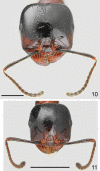Review of the Messorsemirufus complex (Hymenoptera, Formicidae) in Greece
- PMID: 38074900
- PMCID: PMC10698751
- DOI: 10.3897/zookeys.1185.111484
Review of the Messorsemirufus complex (Hymenoptera, Formicidae) in Greece
Abstract
Messor is a diverse genus of Myrmicinae with 168 extant species and subspecies. In the Mediterranean, some of its taxa historically were classified as members of the Messorinstabilis group (sensu Santschi), of which 19 are known from the eastern Mediterranean. Here, the Messorsemirufus complex of the Balkan Peninsula that assembles a distinct subsection of members of the instabilis group is defined and treated. In total, five species are recorded, including three that are new. Messoratanassovii Atanassov, 1982 is redescribed and confirmed for Bulgaria (Thracian Plain, Struma, and Mesta Valley, Pirin Mt., and Eastern Rhodopi) and Greece (Epirus, Ionian Islands, Central and Eastern Macedonia, and Thraki). Three species are described as new to science: Messordanaes Salata, Georgiadis & Borowiec, sp. nov. (Cyclades: Serifos), Messorkardamenae Salata & Borowiec, sp. nov. (Dodecanese: Kos, Nisyros, Rhodes, and Tilos), and Messorveneris Salata, Georgiadis & Borowiec, sp. nov. (Cyclades: Milos). The fifth member of the complex, Messorcreticus Borowiec & Salata, 2019, maintains its status of Cretan endemic.
Keywords: Balkans; Bulgaria; Myrmicinae; eastern Mediterranean; identification key; new species; redescription.
Sebastian Salata, Albena Lapeva-Gjonova, Christos Georgiadis, Lech Borowiec.
Conflict of interest statement
The authors have declared that no competing interests exist.
Figures

















References
-
- André E. (1883) Les fourmis. [concl.]. Pp. 345–404 in: André, Edm. 1881–1886. Species des Hyménoptères d’Europe et d’Algérie. Tome Deuxième. Beaune: Edmond André, 919 pp + 48 pp.
-
- Atanassov N. (1982) Neue Ameisen aus den Gattungen Messor und Cataglyphis (Hymenoptera, Formicidae) für die Fauna Bulgariens. Waldhygiene 14: 209–214.
-
- Bolton B. (1982) Afrotropical species of the myrmecine ant genera Cardiocondyla, Leptothorax, Melissotarsus, Messor and Cataulacus (Formicidae). Bulletin of the British Museum. Entomology 45: 307–370. 10.5281/zenodo.27169 - DOI
-
- Bolton B. (2023) An online catalog of the ants of the world. http://antcat.org [Accessed 22 April 2023]
-
- Borowiec L. (2014) Catalogue of ants of Europe, the Mediterranean Basin and adjacent regions (Hymenoptera: Formicidae). Genus 25: 1–340.
LinkOut - more resources
Full Text Sources
